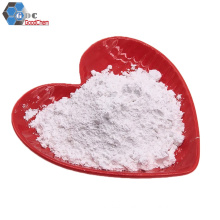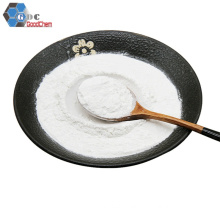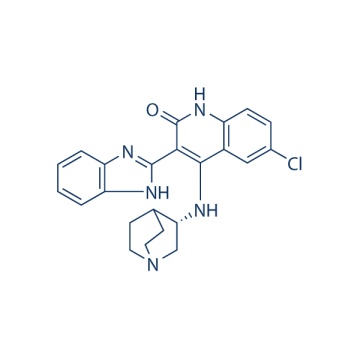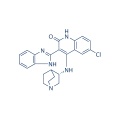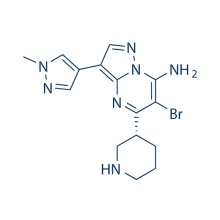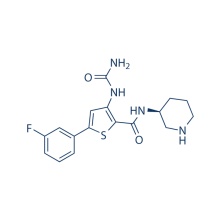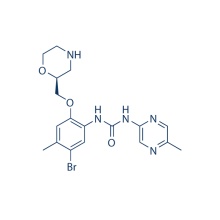.cp_wz tabla {borde superior: 1px sólido #ccc; borde izquierdo: 1px sólido #ccc; } .cp_wz table td {borde derecho: 1px sólido #ccc; borde inferior: 1px sólido #ccc; padding: 5px 0px 0px 5px;} .cp_wz table th {border-right: 1px solid #ccc; border-bottom: 1px solid #ccc; padding: 5px 0px 0px 5px;} \ n Peso molecular: 419,91 CHIR-124 es un inhibidor de Chk1 novedoso y potente con IC50 de 0,3 nM. Muestra una selectividad 2,000 veces mayor contra Chk2, actividad de 500 a 5,000 veces menor contra CDK2 / 4 y Cdc2. \ N Actividad biológica CHIR-124 es una molécula pequeña basada en quinolonas que no está relacionada estructuralmente con otros inhibidores conocidos de Chk1. CHIR-124 interactúa de manera sinérgica con venenos de topoisomerasa (p. Ej., Camptotecina o SN-38) al causar inhibición del crecimiento en una variedad de líneas celulares cancerosas, incluido el carcinoma de mama (MDA-MB-231 y MDA-MB-435) y el carcinoma de colon (SW -620 y Colo205), todos los cuales contienen el gen p53 mutante. CHIR-124 anula los puntos de control S y G2-M inducidos por SN-38 y potencia la apoptosis en las células de cáncer de mama MDA-MD-435. La supresión del punto de control G2-M y la inducción de apoptosis por CHIR-124 se ven potenciadas por la pérdida de p53. CHIR-124 también se dirige de forma potente a otras quinasas como PDGFR y Flt3 con IC50 de 6,6 nM y 5,8 nM, respectivamente. CHIR-124 potencia los efectos inhibidores del crecimiento del irinotecán al anular el punto de control G2-M y aumentar la apoptosis tumoral en un modelo de xenoinjerto de cáncer de mama ortotópico. Protocolo (solo como referencia) Ensayo de quinasa: [1]
|
Chk1 Assay
|
For the Chk1 assay, the kinase domain is expressed in Sf9 insect cells, and a biotinylated cdc25c peptide containing the consensus Chk1/Chk2 phosphorylation site (*)(biotin-[AHX]SGSGS*GLYRSPSMP-ENLNRPR[CONH2]) is used as the substrate. A dilution series of CHIR-124 is mixed with a kinase
reaction buffer containing a final concentration of 30 mM Tris-HCl
(pH 7.5), 10 mM MgCl2, 2 mM DTT, 4 mM EDTA, 25 mMβ-glycerophosphate, 5 mM MnCl2, 0.01% bovine serum albumin, 1.35 nM CHK1 kinase domain, 0.5 μM peptide substrate, and 1 AM unlabeled ATP, plus 5 nM 33Pγ-labeled ATP (specific activity = 2,000 Ci/mmol). Reactions and detection of the phosphate transfer are carried out by a radioactive method. Reactions are incubated at room temperature for 1 to 4 hours and the phosphorylated peptide captured on streptavidin-coated microtiter plates containing stop reaction buffer (25 mM EDTA [ethylenediaminetetraacetic acid], 50 mMHEPES, pH 7.5). Phosphorylated peptide is measured with the DELFIA TRF system using a Europium-labeled anti-phosphotyrosine antibody PT66. The concentration of CHIR-124 for IC50 is calculated using nonlinear regression with XL-Fit data analysis software.
|
Ensayo celular: [1]
|
Cell lines
|
MDA-MB-231, MDA-MB-435, SW-620, and COLO 205 cells
|
|
Concentrations
|
0-2350 nM, dependent on cell types
|
|
Incubation Time
|
48 hours
|
|
Method
|
MDA-MB-231, MDA-MB-435, SW-620, and COLO 205 cells in log-phase are plated into 96-well microplates. CHIR-124 is serially diluted in the presence of six different concentrations of Camptothecin or 0 nM camptothecin. Camptothecin is also serially diluted in the absence of CHIR-124. CHIR-124 is added to cells in 96-well dishes and incubated at 37 °C for 48 hours. Each treatment condition is done in triplicate. Cell proliferation is monitored by the 3-(4,5-dimethylthiazol-2-yl)-5- (3-carboxymethoxyphenyl)-2-(4-sulfophenyl)-2H-tetrazolium (MTS), inner salt assay. MTS inner salt is added to the microplates, which are incubated for another 3 hours, and absorbance at 490 nm is read on a plate reader. The concentrations of each drug in the combinations required to produce 50% inhibition are plotted to generate the isoboles. Isobologram analysis of drug interaction is based the equation of Loewe additivity (1= D A /IC50, A + DB/IC50, B), where IC50, A and IC50, B are the concentrations of drugs to result in 50% inhibition for each drug alone, and DA and DB are concentrations of each drug in the combination that yield 50% overall inhibition. A diagonal line indicating Loewe additivity is included in each graph. Data points that fall below the line indicate synergy, whereas those that fall above the line will indicate antagonism
|
Conversión de diferentes modelos de animales basados en BSA (valor basado en datos del Borrador de Directrices de la FDA)
|
Species
|
Baboon
|
Dog
|
Monkey
|
Rabbit
|
Guinea pig
|
Rat
|
Hamster
|
Mouse
|
|
Weight (kg)
|
12
|
10
|
3
|
1.8
|
0.4
|
0.15
|
0.08
|
0.02
|
|
Body Surface Area (m2)
|
0.6
|
0.5
|
0.24
|
0.15
|
0.05
|
0.025
|
0.02
|
0.007
|
|
Km factor
|
20
|
20
|
12
|
12
|
8
|
6
|
5
|
3
|
|
Animal A (mg/kg) = Animal B (mg/kg) multiplied by
|
Animal B Km
|
|
Animal A Km
|
Por ejemplo, para modificar la dosis de resveratrol utilizada para un ratón (22,4 mg / kg) a una dosis basada en el BSA para una rata, multiplique 22,4 mg / kg por el factor Km para un ratón y luego divida por el factor Km para una rata. Este cálculo da como resultado una dosis equivalente para ratas de resveratrol de 11,2 mg / kg.
|
Rat dose (mg/kg) = mouse dose (22.4 mg/kg) ×
|
mouse Km(3)
|
= 11.2 mg/kg
|
|
rat Km(6)
|
Información química
|
Molecular Weight (MW)
|
419.91
|
|
Formula
|
C23H22ClN5O
|
|
CAS No.
|
405168-58-3
|
|
Storage
|
3 years -20℃Powder
|
|
6 months-80℃in solvent (DMSO, water, etc.)
|
|
Synonyms
|
|
|
Solubility (25°C) *
|
In vitro
|
DMSO
|
7 mg/mL
(16.67 mM)
|
|
Water
|
<1 mg/mL
(
|
|
Ethanol
|
<1 mg/mL
(
|
|
In vivo
|
1% DMSO/30% polyethylene glycol/1% Tween 80
|
30 mg/mL
|
|
|
Chemical Name
|
(S)-3-(1H-benzo[d]imidazol-2-yl)-6-chloro-4-(quinuclidin-3-ylamino)quinolin-2(1H)-one
|
|
Stock Solution (1ml DMSO)
|
1mM
|
10mM
|
20mM
|
30mM
|
|
Mass(mg)
|
0.41991
|
4.1991
|
-
|
-
|
Grupos de Producto : Ciclo celular > Inhibidor de Chk
